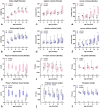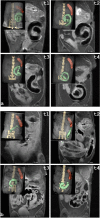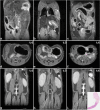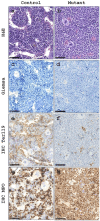Monitoring longitudinal disease progression in a novel murine Kit tumor model using high-field MRI
- PMID: 36028522
- PMCID: PMC9418174
- DOI: 10.1038/s41598-022-17880-y
Monitoring longitudinal disease progression in a novel murine Kit tumor model using high-field MRI
Abstract
Animal models are an indispensable platform used in various research disciplines, enabling, for example, studies of basic biological mechanisms, pathological processes and new therapeutic interventions. In this study, we applied magnetic resonance imaging (MRI) to characterize the clinical picture of a novel N-ethyl-N-nitrosourea-induced Kit-mutant mouse in vivo. Seven C3H KitN824K/WT mutant animals each of both sexes and their littermates were monitored every other month for a period of twelve months. MRI relaxometry data of hematopoietic bone marrow and splenic tissue as well as high-resolution images of the gastrointestinal organs were acquired. Compared with controls, the mutants showed a dynamic change in the shape and volume of the cecum and enlarged Peyer´s patches were identified throughout the entire study. Mammary tumors were observed in the majority of mutant females and were first detected at eight months of age. Using relaxation measurements, a substantial decrease in longitudinal relaxation times in hematopoietic tissue was detected in mutants at one year of age. In contrast, transverse relaxation time of splenic tissue showed no differences between genotypes, except in two mutant mice, one of which had leukemia and the other hemangioma. In this study, in vivo MRI was used for the first time to thoroughly characterize the evolution of systemic manifestations of a novel Kit-induced tumor model and to document the observable organ-specific disease cascade.
© 2022. The Author(s).
Conflict of interest statement
The authors declare no competing interests.
Figures






Similar articles
-
New C3H KitN824K/WT cancer mouse model develops late-onset malignant mammary tumors with high penetrance.Sci Rep. 2022 Nov 17;12(1):19793. doi: 10.1038/s41598-022-23218-5. Sci Rep. 2022. PMID: 36396684 Free PMC article.
-
MRI reveals increased tumorigenesis following high fat feeding in a mouse model of triple-negative breast cancer.NMR Biomed. 2017 Oct;30(10):10.1002/nbm.3758. doi: 10.1002/nbm.3758. Epub 2017 Jun 29. NMR Biomed. 2017. PMID: 28661075 Free PMC article.
-
Magnetic resonance imaging for detection and determination of tumor volume in a genetically engineered mouse model of ovarian cancer.Cancer Biol Ther. 2007 Nov;6(11):1717-25. doi: 10.4161/cbt.6.11.4830. Epub 2007 Aug 3. Cancer Biol Ther. 2007. PMID: 17986851
-
Ultra-high field 1H magnetic resonance imaging approaches for acute hypoxia.Acta Oncol. 2013 Oct;52(7):1287-92. doi: 10.3109/0284186X.2013.824608. Epub 2013 Aug 30. Acta Oncol. 2013. PMID: 23992112
-
Quantitative Clinical Imaging Methods for Monitoring Intratumoral Evolution.Methods Mol Biol. 2017;1513:61-81. doi: 10.1007/978-1-4939-6539-7_6. Methods Mol Biol. 2017. PMID: 27807831 Review.
Cited by
-
New C3H KitN824K/WT cancer mouse model develops late-onset malignant mammary tumors with high penetrance.Sci Rep. 2022 Nov 17;12(1):19793. doi: 10.1038/s41598-022-23218-5. Sci Rep. 2022. PMID: 36396684 Free PMC article.
-
Novel non‑metal‑based contrast agents for MR imaging: Emerging approaches and clinical perspectives (Review).Int J Oncol. 2025 Aug;67(2):70. doi: 10.3892/ijo.2025.5776. Epub 2025 Jul 19. Int J Oncol. 2025. PMID: 40682851 Free PMC article. Review.
-
Improved MRI detection of inflammation-induced changes in bone marrow microstructure in mice: a machine learning-enhanced T2 distribution analysis.Eur Radiol Exp. 2025 Mar 26;9(1):39. doi: 10.1186/s41747-025-00574-1. Eur Radiol Exp. 2025. PMID: 40140174 Free PMC article.
References
Publication types
MeSH terms
LinkOut - more resources
Full Text Sources
Medical
Molecular Biology Databases

